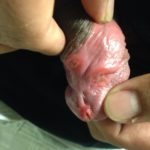Chancre of Primary Syphilis
History of present illness:
A 28-year-old male presents to emergency department with a chief complaint of dysuria over the past seven days associated with a new penile lesion over the same period. He reports sexual activity with “many men and women” without condom use. His review of system is otherwise negative.
Significant findings:
Physical examination revealed a non-tender, erythematous lesion on the glans penis, two similar adjacent satellite lesions, as well as tender inguinal lymphadenopathy. No penile discharge was noted.
Discussion:
Syphilis is a sexually transmitted disease caused by Treponema pallidum. The early stage of the infection consists of three phases – primary syphilis, secondary syphilis and early latent syphilis. The late stage occurs amongst untreated patients, leading to asymptomatic chronic latent disease.1 The feared complication of latent disease is progression to tertiary syphilis, which may occur decades later and includes major cutaneous, musculoskeletal, cardiovascular, and neurological complications.2
Primary syphilis infection manifests as a chancre, a localized, typically painless skin lesion at the site of inoculation. The classic lesion forms a 1-2-centimeter ulcer with a raised, indurated margin commonly with associated moderate regional lymphadenopathy. Chancres are self-limited and heal within six weeks without treatment.1,3
Diagnosis can be made with nontreponemal tests (which are nonspecific) and treponemal tests (which are more complex and expensive, but specific). Nontreponemal tests include the rapid plasma regain (RPR) and venereal disease research laboratory (VDRL). The treponemal test of choice is the fluorescent treponemal antibody absorption (FTA-ABS). Darkfield microscopy in combination with direct fluorescent antibody testing can be used to identify the organism.2,3
The preferred treatment for early syphilis is a single dose of 2.4 million units of intramuscular penicillin G.2,4,5 Our patient was given this treatment, along with empiric coverage for gonorrhea and chlamydia co-infection with ceftriaxone and azithromycin. His RPR and FTA testing was positive, as was his chlamydia DNA polymerase chain reaction (PCR).
Topics:
Primary syphilis, sexually transmitted diseases, chancre.
References:
- Clark EG, Danbolt N. The Oslo study of the natural course of untreated syphilis: an epidemiologic investigation based on a re-study of the Boeck-Bruusgaard material. Med Clin North Am. 1964;48(3):613-23.
- Hook EW III, Marra CM. Acquired syphilis in adults. N Engl J Med. 1992;326(16):1060-1069. doi:10.1056/NEJM199204163261606
- Nobay F, Promes SB. Sexually transmitted diseases. In: Tintinalli JE, Stapczynski J, Ma O, Cline DM, Meckler GD, Cydylka RK, eds. Tintinalli’s Emergency Medicine: A Comprehensive Study Guide. 7th New York, NY: McGraw-Hill; 2011:989-999.
- Clement ME, Okeke NL, Hicks CB. Treatment of syphilis: a systematic review. JAMA. 2014;312(18):1905-17. doi: 10.1001/jama.2014.13259
- Workowski KA, Bolan GA, Centers for Disease Control and Prevention. Sexually transmitted diseases treatment guidelines, 2015. MMWR Recomm Rep. 2015;64(RR-03):1-137.



